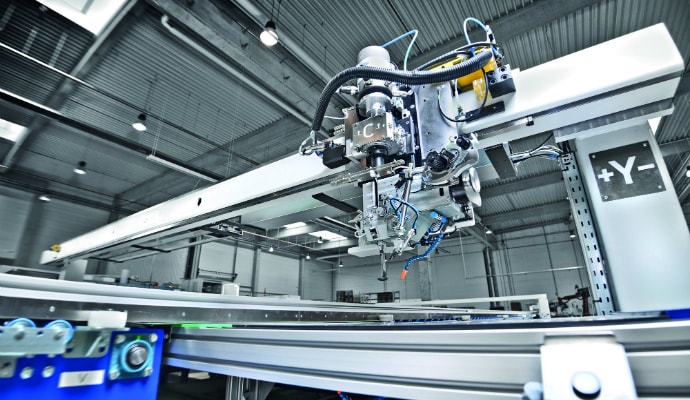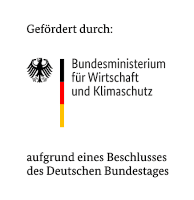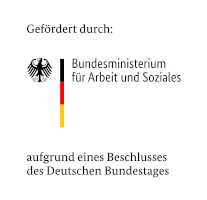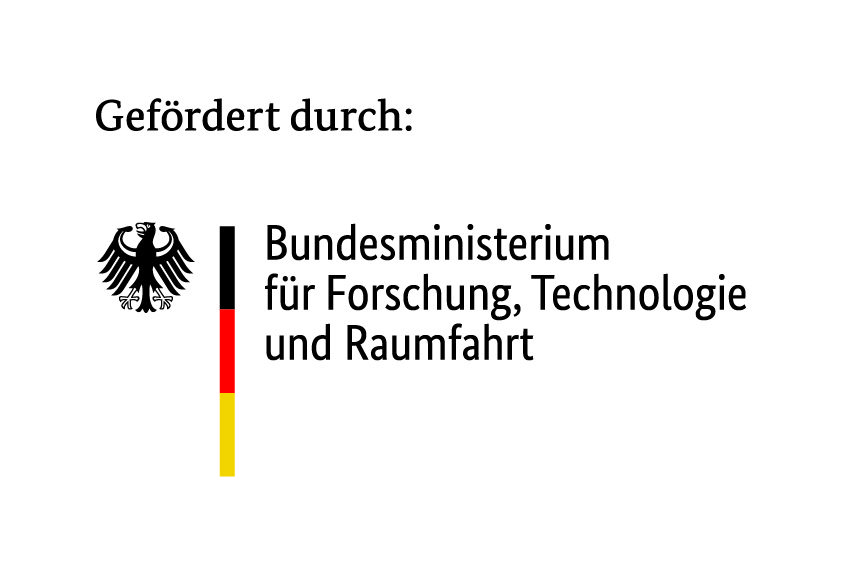Fibre composites in mechanical engineering

While fiber-reinforced lightweight materials are gaining ground in the aerospace industry and now increasingly in the automotive industry – even in series production – plant and mechanical engineers are still hesitant about using lightweight materials. However, these materials are increasingly convincing decision-makers in this area: With their material properties, these materials also provide many advantages for mechanical engineering, including their high innovation potential.
Specific motivation
Current studies conclude that lightweight design with CFRP is now a key issue for machines. CFRP components increase the precision and service life of the systems. Nevertheless, the motives for using CFRP components are somewhat different – for example, in comparison to the series production of automobiles: While car manufacturers focus on reducing energy consumption through lighter vehicles, increasing production efficiency and processing quality are also of great importance in mechanical engineering.
Practical application
The use of highly damping lightweight composite materials enables the considerable reduction of moving masses in the various applications of mechanical engineering. Robot arms made of CFRP, beams in laser cutting machines, chucks, spindle slides in machining centers and high-speed milling machines have already been realized. In addition, ceramic matrix composites are already established in steel production. As production aids, so-called charging racks, they enable long service lives in heat treatment.
Dynamic development
The weight reduction increases the dynamics of the drives and components and reduces the use of energy and resources. The developers are striving to fully exploit the full performance potential of the new materials under defined loads. These actually opposing requirements must be reconciled in advance of product development. This is what the experts at the Fraunhofer IPA are concerned with, for example. They develop strategies to identify and consistently exploit the advantages of lightweight design for mechanical engineering.
Design optimizations
For a high-precision machine tool, low masses and high vibration damping are extremely advantageous. For example, smaller drives and a design for reduced machining forces can be realized. These design optimizations also increase the machining accuracy. Smaller drives cause less structural vibrations and overshoot during acceleration and braking processes is also reduced. Conclusion: Highly damping lightweight composite materials create almost no vibration and thus increase the achievable machining quality. The higher damping also permits higher axis accelerations.
Technical background
Structural vibrations increasingly lead to fatigue fractures, which drastically reduce the service life of machines and assemblies. Higher damping will therefore significantly extend the service life of machines and assemblies. A further advantage: Good damping of these vibrations at the tool holder and in the machine bed leads to better machining results in terms of surface quality and longer tool life.
The composite materials used in mechanical engineering are processed as sandwich and profile constructions. CFRP sheets and profiles can be used for this purpose. The CFRP semi-finished products are increasingly joined by bonding.
Competitive advantages by adaptronics
In many industries, the “new materials” are now a key factor for competitiveness. The range of applications in mechanical engineering extends from coated, super-hard cutting tools and fibre composites in production engineering to lightweight materials and adaptronics for production machines. This latter discipline in particular has a high innovation potential. Professor Holger Hanselka, head of the Fraunhofer Institute for Structural Durability in Darmstadt and co-responsible for the lead project Adaptronics, says: “In ten or twenty years, adaptronics will be part of most products”. Adaptive systems – called ‘smart structures’ – are composite materials equipped with integrated sensors and so-called actuators. They detect component vibrations or deformations that occur. Actuators activate compensating counterforces to reduce or largely prevent the vibrations or deformations. This is made possible by functional materials such as piezoelectric ceramic fibers. They emit electrical signals under pressure – and in the reverse principle they change their linear expansion under electrical stress. They can be integrated into the fiber composites. According to experts, this will give a new boost to lightweight design, because the biggest problem of lightweight components – vibrations and noise – could be solved with adaptronic technology.
Scientific confirmation
Lightweight design is therefore increasingly becoming an issue in mechanical engineering as well. Especially when it comes to highly dynamic processes such as rapid acceleration or braking. One example of this is provided by the Karlsruhe Institute of Technology (KIT), where a new lightweight slide made of CFRP was developed, which is not only significantly lighter than its steel counterpart. Its vibration behavior can also be adapted to the respective application by adding mass. Additional weights influence the natural frequency behavior and thus improve the overall performance of the machine.
Successful products
The Institute for Structures and Composite Structures gGmbH (KVB) and Fiber-Tech Products GmbH in Chemnitz develop and manufacture machine components made of CFRP in Saxony. These include hexapod struts, machine tool main spindles, headstocks for tooth flank grinding machines, claddings, machine grinding tables and equipment carriers.
A lightweight chuck from Emuge-Franken GmbH is already in use. Design manager Friedrich Schmauß: “Carbon and steel are used as material mix. The result is impressive: The weight could be reduced from 460 to 130 kilograms. Energy consumption fell from 22,470 kWh to around 4,000 kWh per year. In addition, the maximum speed could be almost tripled.
Further goals
As already mentioned, lightweight design in mechanical engineering is not always aimed purely at weight reduction, but also at achieving the same or even better material properties through substitution. Hybrid technology is a particularly promising strategy here. Lightweight design must be understood as a cross-sectional technology: It is necessary to cover the entire value-added chain, i.e. from research and development to technical implementation, use of the finished product and recycling at the end of its life cycle. CU has made this the central theme of its work.
Secured strategy
The drastic weight reduction achieved by CFRP designs increases the dynamics of the axes, permits higher speeds and relieves the entire machine. These findings are supported by the test series and research work of renowned institutes. For example, engineers at the Fraunhofer Institute for Production Technology (IPT) in Aachen have investigated the use of fiber-reinforced plastics in mechanical engineering in various projects. They have come to the conclusion that fibre-reinforced composites have a high potential for use in the machine tool sector. Among other things, because they allow higher axle dynamics and the use of smaller drive motors and guide elements, thus contributing significantly to increasing energy efficiency.
Savings potential
The topic of energy consumption, resource conservation and sustainability has become very important in mechanical engineering. The order of magnitude: With a three-shift operation with 7,500 hours per year, a ratio of main time to auxiliary time of 80:20 percent, a process load of 25 kW on average and a basic power requirement of 10 kW (both of course both machine-specific), the energy requirement of a CNC machine corresponds to about 165,000 kWh per year. For comparison: a four-person household consumes on average around 4,000 kWh per year.
Even more advantages
CFRP components are suitable for very stiff constructions that allow high positioning accuracy even under extreme acceleration forces. By the specific selection of fibres and an appropriate layer structure, advantageous E-moduli can be achieved at very low weight, which are almost twice as high as those of steel. CFRP components can also be designed for minimal thermal expansion or almost complete reduction of vibrations.
Significant progress is currently being made in the production of the material, above all by using textile processes in the automated processing of dry semi-finished products. In combination with newly developed, fast-curing matrix resin systems, there is considerable potential for rationalization. In addition, these further developments can be supplemented by sewing, knitting, embroidery and knitting. This also makes it economically possible to arrange the reinforcing fibres in a more load-bearing manner. All in all, these advances will also make the use of CFRP components in mechanical engineering much more economical.
Good arguments
In challenging applications in mechanical engineering, components made of aluminium or steel quickly reach their limits. Carbon fiber composites make it possible to reach new dimensions in the performance of machines and systems. The SGL Group, a founding member of CU, argues: “Our semi-finished and finished parts offer high strength and stiffness as well as good damping behavior. Thanks to the wide range of matrix and carbon fiber materials that can be combined with each other, CFRP components can be produced with material properties that are individually tailored to the specific task”.
Application examples:
• Gripper rods
• connecting rod
• Walking beam
• Rotoryoke
The use of the system is associated with a whole range of advantages:
• higher output quantity
• lower costs in the event of damage
• lower power consumption
• reduced maintenance and thus longer service life
Industrial policy dimension
Mechanical and plant engineering is one of the most important sectors of the German capital goods industry. The megatrends: Industry 4.0, resource-saving environmental protection, energy efficiency and electromobility. The industry is thus an important driver of innovation. The mechanical engineering sector is characterized by medium-sized companies. Around 87 percent of the 6,400 companies have fewer than 250 employees, and around 67 percent fewer than 100 employees (industry average 175). With over one million employees (31.12.2014: 1,008,000), the mechanical and plant engineering sector is the largest employer in Germany. Compared to the previous year, the number of employees increased by over 18,000 (+1.7 percent). In terms of industry turnover, mechanical engineering, at around 212.1 billion euros, is in second place behind vehicle construction (384.4 billion euros) in 2014. While the automotive industry produces in large series, machines and systems are often manufactured as individual items or in small series. With a rate of 76.5 percent (2014), the industry is strongly export-oriented. Europe is our most important market with a share of 55 percent.
Environmental policy dimension
In view of the high energy requirement of the production process, its reduction is more than desirable. Fibre composites can and will make a significant contribution to this.


















